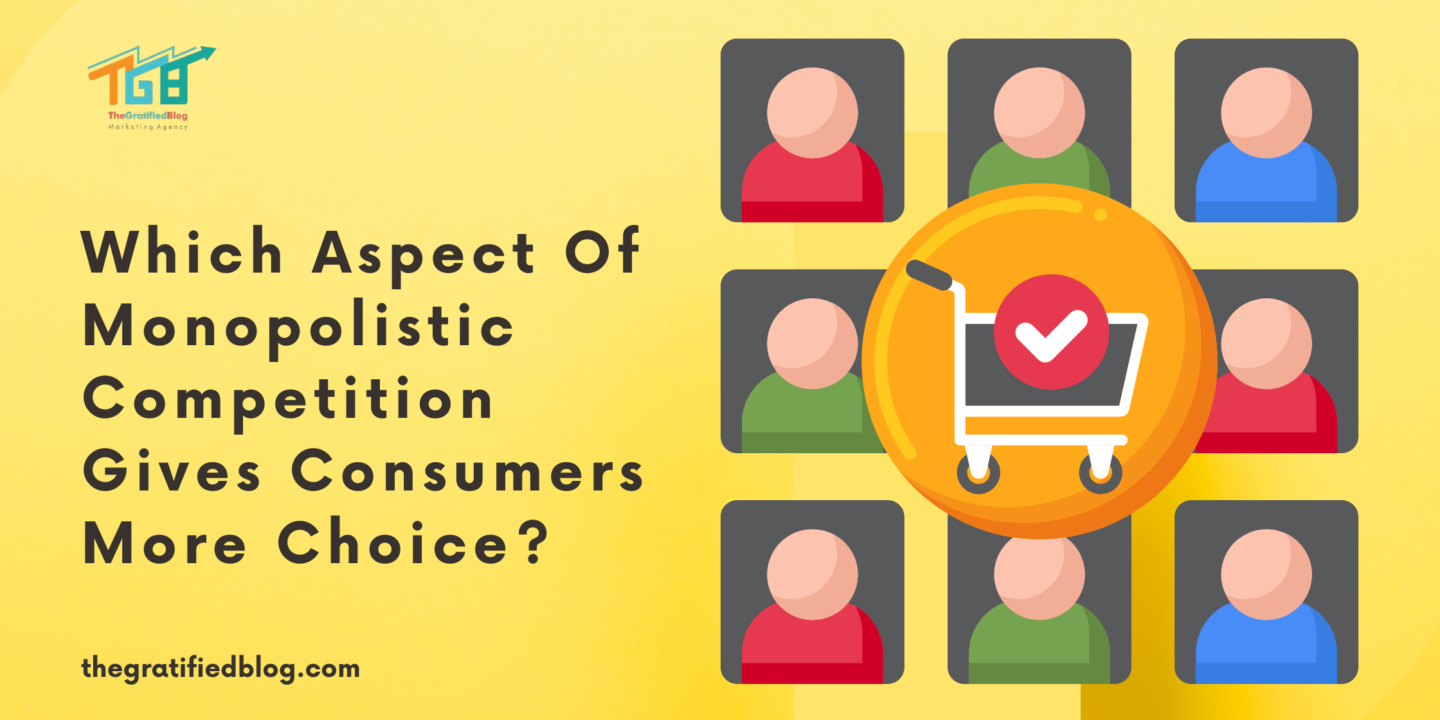
When you walk into a supermarket or browse an online store, you see many brands selling similar products. Think about shampoo, coffee, or even mobile phones. You have so many options, each with its own special features, packaging, and price. This happens because of monopolistic competition, a type of market where many businesses sell products that are similar but slightly different.
Which aspect of monopolistic competition gives consumers more choice? One key factor is product differentiation. Businesses try to stand out by making their products unique in some way. It could be quality, design, branding, or even customer service. This differentiation is what expands consumer choices, allowing people to pick products that best match their needs and preferences. Let us explore how this works and why it benefits consumers.
What Is Monopolistic Competition?
Before we dive deeper, let us understand what monopolistic competition means.
It is a type of market where:
- Many businesses sell similar but not identical products
- Each company tries to differentiate its product from the others
- There are few barriers to entry, so new businesses can join the market easily
- Companies compete based on price, quality, brand image, and advertising
Unlike a monopoly, where only one company controls the market, monopolistic competition allows for variety. This means consumers are not stuck with just one option. Instead, they can pick a product that best suits their needs and preferences.
Which Aspect Of Monopolistic Competition Gives Consumers More Choice?
The main reason monopolistic competition benefits consumers is product differentiation. But what does this mean?
1. More Brands, More Options
In a monopolistic competition market, many businesses offer similar products, but each one adds a unique touch. Take toothpaste as an example. You will find options for:
- Whitening toothpaste
- Cavity protection toothpaste
- Herbal toothpaste
- Charcoal toothpaste
- Sensitivity-friendly toothpaste
Even though all toothpaste serves the same purpose, each brand has something special. This lets consumers choose based on their personal needs.
2. Variety in Prices
Not everyone wants to spend a lot on a product. Some people prefer budget-friendly options, while others look for premium quality. Because businesses try to appeal to different groups, you will find products at various price points.
For example, in the smartphone market:
- Some brands focus on affordability, offering budget-friendly models
- Others aim at premium customers with high-end features
- Some provide mid-range phones with a balance of price and quality
This variety ensures that consumers are not forced to buy a product outside their budget. They can pick what fits their financial situation best.
3. Innovation and New Features
When many businesses compete in the same market, they constantly try to improve their products. They want to attract more customers, so they add new features, better designs, and improved quality.
Think about the evolution of coffee. In the past, instant coffee was the main option. But now, you can find:
- Organic coffee
- Cold brew
- Flavored coffee
- Single-origin coffee
- Ready-to-drink coffee
This level of innovation happens because businesses want to stand out. The benefit? Consumers get exciting new products all the time.
4. Better Branding and Customer Experience
Product differentiation is not just about features. It is also about branding and customer experience. Some companies stand out by offering:
- Eco-friendly packaging for environmentally conscious buyers
- Luxury branding for those who want exclusivity
- Excellent customer service to build trust and loyalty
- Subscription services for convenience
For example, in the clothing industry, some brands focus on affordability, while others promote sustainability. Some offer trendy designs, while others provide timeless classics. Consumers can choose based on their lifestyle and values.
How Does This Benefit Consumers?
Now that we know how product differentiation works, let us look at the real benefits for consumers.
1. Freedom to Choose
Instead of being forced to buy whatever is available, consumers get to pick a product that meets their needs. Whether they want affordability, luxury, or sustainability, they have choices.
2. Custom Products for Different Preferences
Not everyone likes the same thing. Some people prefer strong coffee, while others want a mild blend. Some need gluten-free snacks, while others love regular ones. Monopolistic competition makes sure there is something for everyone.
3. Better Quality Over Time
Since businesses are always trying to improve, consumers benefit from higher quality products. Companies invest in research and technology to make better products than their competitors.
4. Fairer Prices Due to Competition
Because many businesses are competing, no single company can charge whatever price they want. If one brand raises its prices too much, consumers will simply switch to another. This keeps prices reasonable and fair.
5. Exciting New Trends and Innovation
Consumers enjoy new and exciting products because companies must stay creative. Whether it is new flavors, stylish designs, or better technology, there is always something fresh in the market.
Comparison with Other Market Structures
Monopolistic competition is just one type of market structure. To understand why it gives consumers more choice, let us compare it with perfect competition, monopoly, and oligopoly.
Monopolistic Competition vs. Perfect Competition
| Feature | Monopolistic Competition | Perfect Competition |
|---|---|---|
| Number of Sellers | Many | Many |
| Product Differences | Yes, products are slightly different | No, all products are identical |
| Consumer Choice | High, due to product variety | Limited, since all products are the same |
| Price Control | Some influence due to branding and uniqueness | No control, since prices are set by the market |
- Perfect competition offers the lowest prices but very little variety.
- Monopolistic competition allows more choices, as companies can make their products unique.
Monopolistic Competition vs. Monopoly
| Feature | Monopolistic Competition | Monopoly |
|---|---|---|
| Number of Sellers | Many | One |
| Product Differences | Yes, products are slightly different | No, only one option available |
| Consumer Choice | High, with many brands | Very limited, as there is no competition |
| Price Control | Some control due to branding | High, since there is no competition |
- In a monopoly, a single company dominates, so consumers have no choice.
- In monopolistic competition, many businesses compete, giving consumers variety and better prices.
Monopolistic Competition vs. Oligopoly
| Feature | Monopolistic Competition | Oligopoly |
|---|---|---|
| Number of Sellers | Many | Few large companies |
| Product Differences | Yes, products are slightly different | Can be similar or different |
| Consumer Choice | High, with many brands | Limited, since only a few brands control the market |
| Price Control | Some control due to branding | High, since a few companies dominate |
- In an oligopoly, a few large companies control the market, so choices are limited.
- In monopolistic competition, there are many brands, offering more variety to consumers.
Challenges and Drawbacks for Consumers
While monopolistic competition gives consumers more choices, it also has some downsides.
1. Higher Prices Compared to Perfect Competition
Since companies focus on branding, advertising, and making their products look unique, they often charge higher prices. Even though these products may be slightly different, the extra cost does not always mean better quality.
For example:
- A branded sneaker may cost twice as much as a non-branded one, even if both are made with similar materials.
- Premium coffee brands charge more even though their coffee beans come from the same farms as budget brands.
Because businesses spend a lot on marketing, consumers often pay higher prices for a brand name rather than the product itself.
2. Influence of Brand Perception Over True Quality
Consumers sometimes choose a product based on how it is marketed rather than its actual quality. This is because branding, advertising, and packaging create a strong emotional connection.
For example:
- Some beauty products are marketed as premium but have the same ingredients as budget-friendly ones.
- Designer clothing brands charge extremely high prices, even though the quality is not always better than mid-range brands.
This means that in monopolistic competition, brands with strong marketing can sell more, even if their products are not necessarily better. Consumers may sometimes end up paying more for an image rather than real value.
Final Thoughts
Monopolistic competition is great for consumers because it creates variety, improves quality, and keeps prices competitive. The main reason for this is product differentiation, where companies make their products stand out in unique ways.
Thanks to this, consumers are not stuck with just one choice. They can explore different brands, pick the best value, and enjoy constant innovation. Whether it is food, fashion, or technology, monopolistic competition makes sure that there is always something new and exciting in the market.
So next time you shop for a product, take a moment to appreciate the number of choices you have. That is the power of monopolistic competition at work.
Frequently Asked Questions
Q1. Which aspect of monopolistic competition gives consumers more choice?
Ans. Monopolistic competition allows firms to differentiate their products through branding, quality, features, and marketing. This product differentiation means consumers have a variety of options to choose from, catering to different preferences, needs, and price points, enhancing overall consumer choice and satisfaction.
Q2. Why is monopolistic competition good for consumers?
Ans. Monopolistic competition benefits consumers by offering a diverse range of products, competitive pricing, and continuous innovation. Since firms strive to stand out, they invest in better quality, improved services, and marketing strategies, ensuring that consumers have more choices and often better value for their money.
Q3. What aspects of a perfectly competitive market does a monopolistic competition have?
Ans. Monopolistic competition shares characteristics with perfect competition, such as a large number of firms, low barriers to entry and exit, and independent pricing strategies. However, unlike perfect competition, products are differentiated rather than identical, giving firms some control over pricing.
Q4. How do firms in monopolistic competition get customers?
Ans. Firms in monopolistic competition attract customers through product differentiation, branding, advertising, promotions, and customer service. They create unique selling points, enhance product appeal, and build brand loyalty, allowing them to stand out in a crowded market and influence consumer purchasing decisions.








No Comments